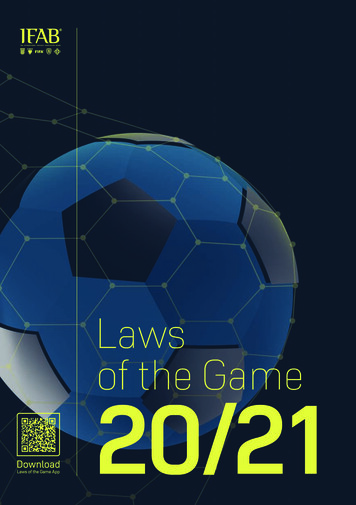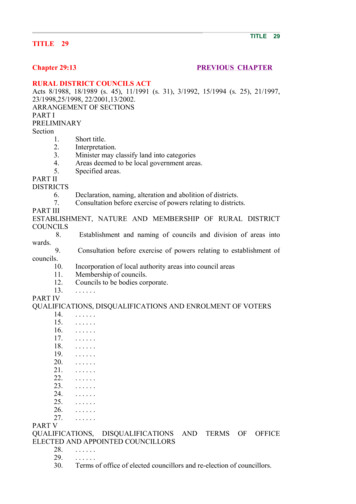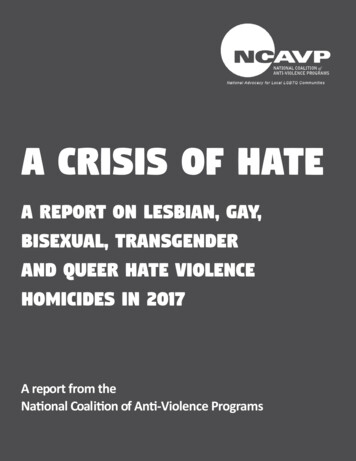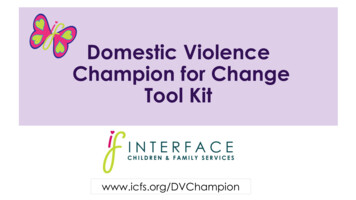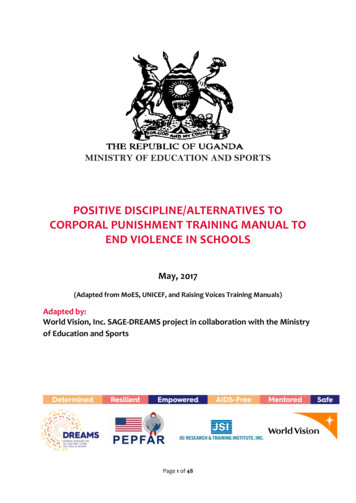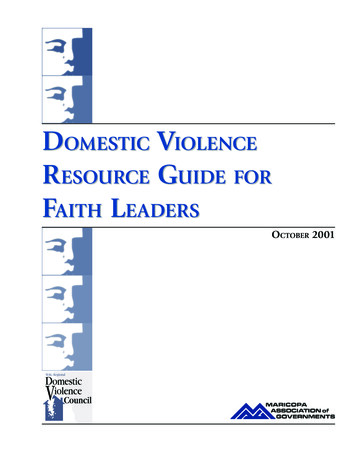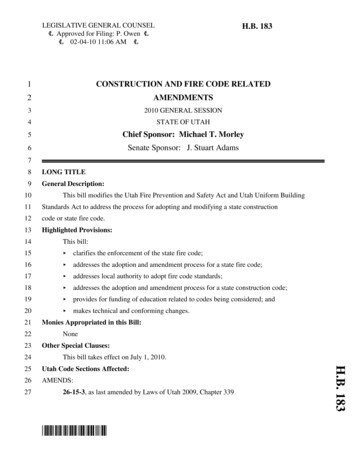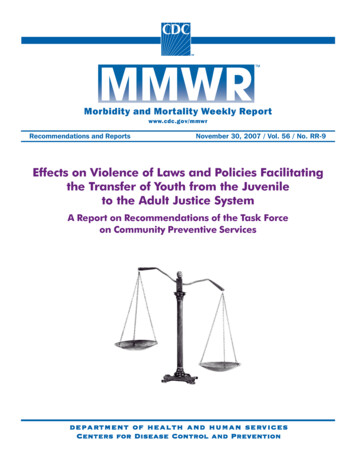
Transcription
Morbidity and Mortality Weekly Reportwww.cdc.gov/mmwrRecommendations and ReportsNovember 30, 2007 / Vol. 56 / No. RR-9Effects on Violence of Laws and Policies Facilitatingthe Transfer of Youth from the Juvenileto the Adult Justice SystemA Report on Recommendations of the Task Forceon Community Preventive Servicesdepartment of health and human servicesdepartmentservicesCenters for Disease Control and Prevention
MMWRCONTENTSThe MMWR series of publications is published by the CoordinatingCenter for Health Information and Service, Centers for DiseaseControl and Prevention (CDC), U.S. Department of Health andHuman Services, Atlanta, GA 30333.Suggested Citation: Centers for Disease Control and Prevention.[Title]. MMWR 2007;56(No. RR-#):[inclusive page numbers].Background . 1Introduction . 3Methods . 3Results . 6Specific Deterrence Effects . 6Centers for Disease Control and PreventionJulie L. Gerberding, MD, MPHDirectorTanja Popovic, MD, PhDChief Science OfficerJames W. Stephens, PhDAssociate Director for ScienceSteven L. Solomon, MDDirector, Coordinating Center for Health Information and ServiceJay M. Bernhardt, PhD, MPHDirector, National Center for Health MarketingKatherine L. Daniel, PhDDeputy Director, National Center for Health MarketingEditorial and Production StaffFrederic E. Shaw, MD, JDEditor, MMWR SeriesSuzanne M. Hewitt, MPAManaging Editor, MMWR SeriesTeresa F. RutledgeLead Technical Writer-EditorDavid JohnsonProject EditorBeverly J. HollandLead Visual Information SpecialistLynda G. CupellMalbea A. LaPeteVisual Information SpecialistsQuang M. Doan, MBAErica R. ShaverInformation Technology SpecialistsEditorial BoardWilliam L. Roper, MD, MPH, Chapel Hill, NC, ChairmanVirginia A. Caine, MD, Indianapolis, INDavid W. Fleming, MD, Seattle, WAWilliam E. Halperin, MD, DrPH, MPH, Newark, NJMargaret A. Hamburg, MD, Washington, DCKing K. Holmes, MD, PhD, Seattle, WADeborah Holtzman, PhD, Atlanta, GAJohn K. Iglehart, Bethesda, MDDennis G. Maki, MD, Madison, WISue Mallonee, MPH, Oklahoma City, OKStanley A. Plotkin, MD, Doylestown, PAPatricia Quinlisk, MD, MPH, Des Moines, IAPatrick L. Remington, MD, MPH, Madison, WIBarbara K. Rimer, DrPH, Chapel Hill, NCJohn V. Rullan, MD, MPH, San Juan, PRAnne Schuchat, MD, Atlanta, GADixie E. Snider, MD, MPH, Atlanta, GAJohn W. Ward, MD, Atlanta, GAGeneral Deterrence Effects . 8Discussion . 8Research Needs . 9Use of the Recommendations . 9Acknowledgment . 10References . 10
Vol. 56 / RR-9Recommendations and Reports1Effects on Violence of Laws and Policies Facilitatingthe Transfer of Youth from the Juvenileto the Adult Justice SystemA Report on Recommendations of the Task Forceon Community Preventive Services*Prepared byRobert Hahn, PhD1Angela McGowan, JD1Akiva Liberman, PhD2Alex Crosby, MD3Mindy Fullilove, MD4Robert Johnson, MD5Eve Moscicki, ScD6LeShawndra Price, PhD6Susan Snyder, PhD1Farris Tuma, ScD6Jessica Lowy1Peter Briss, MD1Stella Cory, MD1Glenda Stone, PhD11Division of Health Communications, National Center for Health Marketing, CDC2National Institute of Justice, Washington, District of Columbia3Division of Violence Prevention, National Center for Injury Prevention and Control, CDC4Columbia University, New York, New York, and Task Force on Community Preventive Services5New Jersey Medical School, Department of Pediatrics, Newark, New Jersey, and Task Force on Community Preventive Services6National Institute of Mental Health, Bethesda, MarylandSummaryThe independent, nonfederal Task Force on Community Preventive Services (Task Force), which directs the development ofthe Guide to Community Preventive Services (Community Guide), conducted a systematic review of published scientificevidence concerning the effectiveness of laws and policies that facilitate the transfer of juveniles to the adult criminal justicesystem to determine whether these transfers prevent or reduce violence among youth who have been transferred and among thejuvenile population as a whole. For this review, transfer is defined as placing juveniles aged 18 years under the jurisdictionof the adult criminal justice system. The review followed Community Guide methods for conducting a systematic review ofliterature and for providing recommendations to public health decision makers. Available evidence indicates that transfer tothe adult criminal justice system typically increases rather than decreases rates of violence among transferred youth. Availableevidence was insufficient to determine the effect of transfer laws and policies on levels of violent crime in the overall juvenilepopulation. On the basis of these findings, the Task Force recommends against laws or policies facilitating the transfer ofjuveniles to the adult criminal justice system for the purpose of reducing violence.* Points of view expressed are those of the contributors and the Task Force onCommunity Preventive Services and do not necessarily reflect those of CDC,the National Institutes of Health, the National Institute of Justice, the U.S.Department of Justice, or the U.S. Department of Health and Human Services.The material in this report originated in the National Center forHealth Marketing, Jay M. Bernhardt, PhD, Director; and the Divisionof Health Communication and Marketing, Cynthia E. Baur, PhD,Director.Corresponding preparer: Robert A. Hahn, National Center forHealth Marketing, 1600 Clifton Road, MS E-69, Atlanta, GA 30333.Telephone: 404-498-0958; Fax: 404-498-0989; E-mail: rah1@cdc.gov.BackgroundThe purpose of this review was to determine whetherlaws or policies that facilitate the transfer of juveniles fromthe juvenile to the adult criminal justice system reduceinterpersonal violence, either specifically among juvenileswho have experienced the adult justice system or in thegeneral juvenile population. One rationale for the transferof juveniles to the adult justice system is to deter futurecriminal activity, on the premise that the adult system ismore severe and punitive than the juvenile system. For thisreview, transfer (also referred to as “waiver” to denote the
2MMWRrelinquishing of authority by the juvenile courts) refers toplacing juveniles under the jurisdiction of the adult criminal justice system. Although the legal term “juvenile” isdefined differently among states, for purposes of this review,a juvenile is considered a person aged 18 years. Juvenileswho are not transferred to the adult court system are saidto be retained in the juvenile system.The reduction of violence through transfer policies ishypothesized to occur by two mechanisms—specificdeterrence and general deterrence—both of which rely onthe perceived severity of the adult criminal justice systemcompared with the juvenile system. “Specific deterrence”refers to juveniles who have been subjected to the adultjustice system and “general deterrence” refers to all youthin the population who might be subject to transfer provisions if charged with a crime. “Deterrence” applies to thebehavioral outcome of reduced offending or re-offendingand not to decision processes made by the affected youth.Incapacitation is the inability of incarcerated convicts tocommit crimes in society during incarceration; incapacitation is thought to be increased for juveniles in adultsettings compared with those in juvenile settings.In a representative national survey in 2002, rates of theperpetration of violent crime, including simple and aggravated assault, robbery, and rape, were highest among persons aged 15–20 years (1,2). U.S. adults reportedapproximately 1.9 million incidents of victimization byperpetrators estimated to be aged 12–20 years, a rate of5.1 incidents per year of victimization per 100 juveniles inthis age group (3,4). Although arrest and victimization dataindicate declines among juveniles for violent acts in generalfollowing a peak during 1993–1994, self-report of offensescontinues to indicate high rates of violence (3).Juvenile and criminal law in the United States are principally state matters. Juvenile courts were first established in1899 in Illinois. By 1925, all states except Maine andWyoming had separate juvenile courts (5). Separate judicial process for juveniles has been justified on several groundsrelated to the psychosocial development of this population(6). Certain developmental differences are cited in justification of the Supreme Court decision to ban capital punishment for crimes committed by offenders aged 18 yearsat the time of the crime (7). In general, juveniles differfrom adults in their biologic development and mental processes and capacities. Juveniles are less aware of consequences, less able to regulate impulses or inhibit behavior,and thus less culpable for their actions than adults. Inaddition, juveniles have less ability to understand and thusparticipate in the standard adult judicial process (8). Finally,juveniles are more malleable and amenable to reform ofNovember 30, 2007their behavior. Therefore, an emphasis of the judicialresponse to their deviant behavior should be on reform ratherthan, or in addition to, punishment—in contrast to thepunitive focus of the adult criminal justice system (6). Thepolicy implications of these developmental issues withrespect to court jurisdiction remain controversial, especiallybecause of the variations in adolescent cognitive and socialdevelopment for which chronologic age is not a precisemarker.In contrast to the adult criminal court, which is orientedtoward punishment, the traditional juvenile court has acted“in the interests of the child” and focused on rehabilitationrather than punishment because juveniles are assumed to bemore amenable than adults to treatment (9). Juvenile courtsin the United States have always followed the principle ofparens patriae—the state acts as a guardian for those whocannot take care of themselves, such as children and thementally ill (10,11). Traditionally, transfer from juvenile toadult court jurisdiction has required a determination thatthe juvenile was not amenable to treatment (5,10). Recentchanges to the juvenile court’s mission weighs protection ofthe community and the interests of the child (11).Although states establish their own juvenile and adultcriminal law, common trends are discernible across states.Following the increases in violent juvenile crime in the late1980s and early 1990s, during 1992–1999, all statesexcept Nebraska expanded their transfer provisions tofacilitate prosecuting juveniles in the adult justice system(12–16). An estimated 210,000–260,000 juveniles, or20%–25% of all juvenile offenders, were prosecuted asadults in 1996 (14).Persons aged 18 years can be tried in the adult criminaljustice system by one of six main mechanisms. In “judicialwaiver,” the traditional mechanism, a juvenile court judgecan waive a youth to the adult system, generally based onperceived lack of amenability to treatment, which is oftenbased on considerations such as age, seriousness of the current offense, and previous delinquency (13). In“prosecutorial waiver,” the prosecutor has the discretion tofile a case in the juvenile or the adult criminal court system. In “statutory exclusion,” youth of particular agescharged with particular crimes (e.g., homicide) are excludedby statute from juvenile justice system jurisdiction. Whenparticular charges are excluded from juvenile court by statutory means, discretion resides with prosecutors, who decide which charges are filed; choice of charge mightdetermine whether the juvenile is transferred (15).The increases in transfer resulting from the precedingthree mechanisms are amplified by a policy that “once anadult, always an adult,” whereby youth once transferred to
Vol. 56 / RR-9Recommendations and Reportsadult court also are automatically transferred for any futureoffending (13). With lowered age of adult court jurisdiction, states set the age at which a person is consideredresponsible for criminal actions, and no longer eligible forjuvenile court, to an age younger than the traditional ageof 18 years. Finally, in certain states, juveniles who are married or otherwise “emancipated” (i.e., released from parentalauthority) are excluded from juvenile court. In a mechanismtypically referred to as “reverse waiver,” youth who have notreached the age of majority can be transferred from the adultcourt back to the juvenile court when cases are deemedinappropriate for the adult criminal court system.States also are experimenting with “blended sentencing,”which allows a juvenile to be sentenced to both juvenileand adult sanctions by one court. Blended sentencing bythe juvenile court allows the court to monitor youthbeyond the traditional end of juvenile jurisdiction (16).This frequently involves juvenile incarceration until the ageof majority, followed by adult incarceration. Greater sentencing flexibility might reduce the pressure to transfercourt jurisdiction, but little research has been conductedon how blended sentencing is used in practice (17).IntroductionThe independent, nonfederal Task Force on CommunityPreventive Services (Task Force) develops the Guide to Community Preventive Services (Community Guide), with the support of the U.S. Department of Health and Human Services(DHHS), in collaboration with public and private partners (18,19). Although CDC provides staff support to theTask Force for development of the Community Guide, therecommendations presented in this report were developedby the Task Force and do not necessarily reflect the viewpoints of CDC or DHHS.This report is one in a series included in the CommunityGuide, a resource that includes multiple systematic reviewsaddressing preventive public health topics (e.g., violenceprevention, preventing tobacco use, and reducing the incidence of cancer) (19). This section provides an overview ofthe process used by the Task Force to select and review evidence and summarize its recommendations regardinginterventions to prevent or reduce violence. A full report onthe recommendations, supporting evidence, and remainingresearch questions regarding the effects of strengthened transferlaws and policies on violence is published elsewhere (20).Using effective interventions to reduce violence might helpto achieve certain objectives specified in Healthy People 2010(21), the disease prevention and health promotion agendafor the United States. Healthy People 2010 objectives iden-3tify some of the substantial preventable threats to healthand can help focus the efforts of public health systems,legislators, and law enforcement officials for addressingthose threats by establishing measurable targets. Many ofthe Healthy People 2010 objectives regarding injury andviolence prevention (e.g., the reduction of rates of assault,homicide, rape, and robbery) might be positively affectedby the intervention reviewed in this report.MethodsIn this review, Community Guide procedures were usedto assess systematically whether policies that facilitate thetransfer of juveniles from the juvenile to adult criminal justice system have been effective in reducing violence amongjuveniles. Community Guide methods for systematic reviewshave been discussed elsewhere (22). In the CommunityGuide, evidence is summarized about the effectiveness ofinterventions in changing one or more health-related outcomes and about other positive or negative effects of theintervention. If an intervention is effective, evidence also issummarized regarding the applicability of the findings(i.e., the extent to which available effectiveness data mightapply to diverse populations and settings), other harms orbenefits of the intervention, economic efficiency, andbarriers to the implementation of the intervention.As with other Community Guide reviews, the process usedto review evidence systematically and then translate thatevidence into conclusions involves forming a systematicreview development team; developing a conceptual approachto organizing, grouping, and selecting interventions;selecting interventions to evaluate; searching for andretrieving evidence; assessing the quality of and abstractinginformation from each study; assessing the quality of anddrawing conclusions about the body of evidence (i.e., allavailable evidence combined) of effectiveness; and translating the evidence of effectiveness into recommendations.Three groups comprised the systematic review development team: the coordination team, the consultation team,and the abstraction team.* The coordination team (“theteam”) consisted of a Task Force member, specialists in systematic reviews and economics from the Community Guide*Systematic review team: Coordination team: Robert Hahn, PhD; AngelaMcGowan, JD; Akiva Liberman, PhD; Alex Crosby, MD; Mindy Fullilove,MD; Robert Johnson, MD; Eve Moscicki, ScD; LeShawndra Price, PhD;Susan Snyder, PhD; Farris Tuma, ScD; Jessica Lowy, MPH; Peter Briss, MD;Stella Cory, MD; Glenda Stone, PhD. Consultation team: Danielle LaRaque,MD; Colin Loftin, PhD; James Mercy, PhD; Laurie Anderson, PhD; SuzanneSalzinger, PhD; Patricia Smith; Dick Bathrick. Abstraction team: Robert Hahn,PhD; Angela McGowan, JD; Akiva Liberman, PhD.
4MMWRBranch (National Center for Health Marketing, CDC), andauthorities on violence from the National Center for Injury Prevention and Control (CDC), the National Institutes of Health (NIH), and the National Institute of Justice(NIJ). This team developed the conceptual framework forthe review; coordinated the data collection and review process; and drafted evidence tables, summaries of the evidence,and the reports. The abstraction team—three members ofthe coordination team—determined which studies metCommunity Guide standards for inclusion in the systematicreview and collected and recorded data from these studies.The consultation team members—national authorities onviolence-related topics—nominated interventions to be reviewed, participated in the selection of priority interventions for review, provided advice, and reviewed the finalproducts.Searches for published research were conducted in eightcomputerized databases: the National Criminal JusticeReference Service (NCJRS), Education Resources Information Center (ERIC), PsycINFO, Wilson Social SciencesAbstracts, Social SciSearch, National Technical InformationService (NTIS), Medline, and Lexis/Nexis.† Search termsincluded “juvenile transfer” and its synonyms (e.g.,“waiver”), and “efficacy” and “recidivism.” Relevant references listed in retrieved articles were evaluated and obtained,and subject-matter specialists were consulted to find additional published reports. The coordination team conductedInternet searches to ensure that no additional studies couldbe found by these means. Journal articles, governmentreports, books, and book chapters were eligible for inclusionin the review.Articles published in any year before February 2003§ wereconsidered for inclusion if they evaluated a new or strength†§These databases can be accessed as follows: NCJRS: http://abstractsdb.ncjrs.org/content/AbstractsDB Search.asp; ERIC: http://www.askeric.org/Eric/;PsycInfo: DIALOG http://www.dialogclassic.com (requires id/passwordaccount), ; Wilson SocialSciences Abstracts: tml(requires id/password account); Social SciSearch: tml (requires id/password account); NTIS:DIALOG http://www.dialogclassic.com (requires id/password account),http://grc.ntis.gov/ntisdb.htm; Medline: http://www.ncbi.nlm.nih.gov/PubMed; Lexis/Nexis: www.lexisnexis.com.Two articles were published on the general deterrent effects of strengthenedtransfer laws after the completion of this review. (Steiner B, Hemmens C, BellV. Legislative waiver reconsidered: general deterrent effects of statutory exclusionslaws enacted post-1979. Justice Q 2006;23:34–59. Steiner B, Wright E.Assessing the effects of state direct file waiver laws on violent juvenile crime:deterrence or irrelevance? J Crim Law Criminology 2006;96:1451–77.)Although findings from these studies are not included in this review, they areamong the stronger studies regarding the general deterrence effect of increasingtransfer. Both studies used time series methods to examine the effects ofincreased statutory exclusion and direct file in individual states. In bothstudies, the findings indicate that transfer laws do not promote the generaldeterrence of violent crime.November 30, 2007ened transfer policy or law; assessed at least one of the specified transfer-related violent outcomes as measured by arrest rates for crimes designated as “violent” (e.g., robberyor assault); were conducted in a country with a high-income economy¶ (as defined by the World Bank); reportedon a primary study rather than a guideline or review; andcompared a group of persons exposed to the intervention(i.e., law or policy) with a comparison group that had notbeen exposed or who had been less exposed. While searching for evidence, the team also sought information abouteffects on other outcomes (i.e., not violence-related), suchas reductions in property crime and disproportionate minority representation among transferred juveniles.Design suitability was assessed for each candidate study(those meeting the inclusion criteria). The review team’sassessment might result in classification of study designthat differs from the nomenclature used by study authors. According to Community Guide nomenclature, greatest design suitability refers to studies with a concurrentcomparison group and prospective data collection; moderate design suitability refers both to retrospective studiesand studies with one pre-intervention and multiple postintervention measurements but no concurrent comparisongroup; and least suitable design refers to cross-sectional studies or studies with only single pre- and post-interventionmeasurements and no concurrent comparison groups.Research on specific deterrence uses different studydesigns and effect measures than research on general deterrence. In specific deterrence research, studies aim to compare the recidivism (subsequent criminal activity) of youthtransferred to the adult justice system with the recidivismof youth retained in the juvenile system. Transferring juveniles to the adult criminal justice system might involve acourt with more formal and adversarial procedures, fewerpossibilities of pretrial diversion from court, differentdetention alternatives, and different sanctions. In this review,outcomes of transferred versus retained juveniles were compared, whether or not the juveniles had been found guilty(or the juvenile court equivalent, adjudicated “delinquent”),or sanctioned.¶High-income economies as defined by the World Bank are Andorra, Antigua& Barbuda, Aruba, Australia, Austria, Bahamas, Bahrain, Barbados, Belgium,Bermuda, Brunei Darussalem, Canada, Cayman Islands, Channel Islands,Cyprus, Czech Republic, Denmark, Estonia, Faeroe Islands, Finland, France,French Polynesia, Germany, Greece, Greenland, Guam, Hong Kong (China),Iceland, Ireland, Isle of Man, Israel, Italy, Japan, Republic of Korea, Kuwait,Liechtenstein, Luxembourg, Macao (China), Malta, Monaco, Netherlands,Netherlands Antilles, New Caledonia, New Zealand, Norway, Portugal, PuertoRico, Qatar, San Marino, Singapore, Slovenia, Spain, Sweden, Switzerland,Taiwan (China), United Arab Emirates, United Kingdom, United States, andU.S. Virgin Islands.
Vol. 56 / RR-9Recommendations and ReportsA major methodologic concern in studies of specificdeterrence is selection bias: transfer to adult criminal courtis typically intended for those youth who are considered tobe more serious offenders. Consequently, transferred youthwould be expected to have greater risk for subsequentviolence, independent of any effect of their experience withthe adult criminal justice system. All of the included studies attempted to control for possible selection bias byrestricting the cases under consideration to serious onesthat would be eligible for transfer and by comparing theoutcomes of cases transferred with those of cases retainedin the juvenile system. In addition, they attempted toreduce selection bias by one of three methods: 1) by usingstatistical methods to control for factors that might affecttransfer decisions (23–25); 2) by matching transferred andretained juveniles on background characteristics (26,27);or 3) by comparing the outcomes of juveniles matched onbackground demographics, economics, and crime characteristics, but in jurisdictions with difference transfer laws(28). Because juveniles charged with minor offenses areunlikely to be transferred, and juveniles charged withextremely serious offenses are unlikely to be retained, studies that match or otherwise control for severity of criminalbackground will probably exclude juveniles at bothextremes.In general deterrence research, outcomes are measured interms of offending rates in the general population of juveniles (e.g., the number of juveniles per 100,000 arrestedfor violent crimes). Comparison groups must necessarilybe in another place or of a different age. Researchers strivefor comparison groups unaffected by the transfer law beingstudied but who are otherwise as similar as possible andsimilarly affected by many of the other social forces thatinfluence offending.The team’s assessment of general deterrence included onlystudies that compared rates of violence before and afterimplementation of a strengthened transfer policy and useda separate comparison group. Juvenile offending rates changeover time for many reasons, as evidenced by the dramaticincrease and then decrease in crime in general and in juvenile violence in particular during the late 1980s and early1990s (29,30). Without comparison groups, any lawenacted during a period of decline in crime would seem tohave a deterrent effect, as indicated by simple before-andafter differences in offending within the same population.As a result, the team considered comparison groups unaffected by the law to be a critical design feature in evaluating the deterrent effect on crime of this particular law.The team assessed limitations in the execution of all candidate studies. Limitations included failure to describe5study population, use of proxy rather than direct measuresof violent outcomes (e.g., general offending outcomes [suchas re-arrest] rather than violent offending), and not controlling for background characteristics of transferred andretained juveniles. This assessment might differ from anassessment of limitations for the study’s original purposes.Using Community Guide methods (22), each study couldbe coded for as many as nine specific limitations: goodexecution refers to studies with one or fewer limitations,fair execution to studies with 2–4 limitations, and limitedexecution to studies with five or more limitations. Studieswith limited execution did not qualify for the review.Unless otherwise noted, results of each study are presentedas the relative change in violent crime rates attributable tothe interventions. Relative change was calculated as relative percent change using the following formulas:Effect size (Ipost/Ipre) / (Cpost/Cpre) – 1whereIpost is the last reported outcome rate in the interventiongroup after the intervention;Ipre is the reported outcome rate in the intervention groupimmediately before the intervention;Cpost is the last reported outcome rate in the comparisongroup after the intervention;Cpre is the reported outcome rate in the comparison groupimmediately before the intervention.In specific deterrence studies, intervention groups werecomposed of transferred juveniles, and control groups werecomposed of juveniles retained in the juvenile system. Ingeneral deterrence studies, intervention groups were populations of juveniles (e.g., in states or cities) exposed to achanged transfer policy, and control groups were populations not exposed to such a change.If results were reported from logistic regression models,odds ratios were transformed into relative rate changes(31,32) so that these effect measures could be more appropriately compared with other studies in the body ofevidence.** If effect measures could not be converted intorelative percent changes (e.g., results presented only ingraphs), the reported findings are described in the text. Inthe reporting of study findings, the standard two-tailedp-value of 0.05 was used as a measure of statistical significance.** RR OR/ ( (1 – P0) (P0 x OR)), where RR is the relative risk, OR the oddsratio to be converted, and P0 is the incidence of the outcome of interest in theunexposed population (i.e., juveniles retained in the juvenile justice system).
6MMWRWhen available, measures adjusted for potential confounders through multivariate analysis were preferred over crudeeffect measures. Follow-up periods of 1 year were considered a limitation. When studies included several follow-upperiods, the longest period available was used.Using standard Community Guide methods (22), the findings of individual studies were aggregated, and the strengthof the body of evidence was summarized on the basis of thenumber of available studies, the strength of their designand execution, and the magnitude and consistency of effects.For an e
Department of Justice, or the U.S. Department of Health and Human Services. Background The purpose of this review was to determine whether laws or policies that facilitate the transfer of juveniles from the juvenile to the adult criminal justice system reduce interpersonal violence, either specifically among juveniles who have experienced the .

